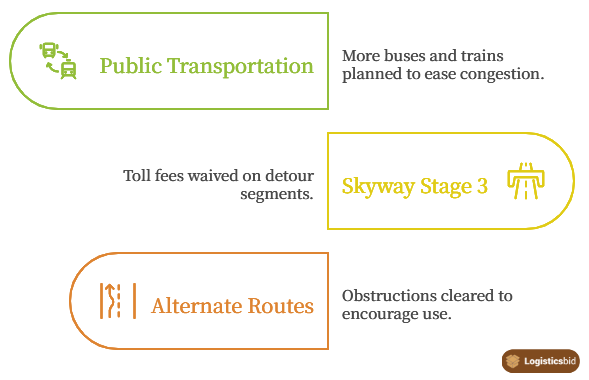
Latest Update:
The implementation of the odd-even scheme originally planned for this month is now canceled following the suspension of the EDSA Rebuild Project. Citizens are encouraged to stay tuned for further updates from the MMDA regarding future traffic management plans.
The Metropolitan Manila Development Authority (MMDA) is set to reintroduce an odd-even number-coding scheme along EDSA, Metro Manila’s main thoroughfare, starting June 16, 2025. This initiative, a part of the EDSA Rehab, aims to mitigate traffic congestion. Here’s a comprehensive look at how this odd-even scheme operates, the motivations behind its implementation, and its broader impact on traffic management.
Introduction to the Odd-Even Traffic Scheme

The odd-even scheme restricts vehicles with license plates ending in odd digits (1, 3, 5, 7, 9) from using EDSA on Mondays, Wednesdays, and Fridays. Those with plates ending in even numbers (0, 2, 4, 6, 8) are restricted on Tuesdays, Thursdays, and Saturdays. All vehicles are permitted on Sundays.
Historical Context
Historically, the odd-even scheme was utilized in Metro Manila to alleviate traffic congestion but was discontinued in 2017 due to public opposition. Its reemergence is associated with the impending EDSA rehab, which aims to improve infrastructure, including the bus and southbound lanes.
The Need for EDSA Rehabilitation
Why Now?
The rehabilitation is part of a long-term strategy to enhance Metro Manila’s traffic infrastructure. Current traffic conditions and maintaining infrastructure necessitate significant updates to accommodate increasing vehicle volumes and ensure road safety and efficiency.
MMDA Reports: The MMDA noted that sections of EDSA required urgent repairs to prevent further deterioration and to cater to future traffic demands.
Government Goals: The government targets completion of the EDSA rehabilitation by 2027, focusing on long-term solutions to recurring traffic issues.
Impact on Commuters
The anticipated roadworks are expected to cause temporary disruptions, necessitating efficient traffic management solutions such as the odd-even scheme to maintain flow and minimize delays for commuters.
Traffic Management During Rehabilitation
Complementary Measures

In conjunction with the odd-even scheme, authorities are deploying additional measures to ease congestion:
- Public Transportation Enhancements: Transportation Secretary Vince Dizon has announced plans for more buses along the EDSA busway and increased MRT-3 train services.
- Motorbike-Specific Lanes: Designated lanes for motorbikes are being evaluated to ensure the safety and efficiency of two-wheeled vehicles.
- Skyway Stage 3: Toll fees on selected segments serving as detours will be waived to facilitate smoother traffic.
- Alternate Routes: Authorities are committed to clearing obstructions on secondary routes to encourage use and reduce congestion on main arteries.
Exemptions
-
TNVS Flexibility
Proposed exemptions for Transport Network Vehicle Services (TNVS) aim to sustain efficient ride-sharing services without undermining traffic reduction efforts.
-
Environmental Incentives
Electric and hybrid vehicles are exempt from the odd-even scheme, promoting eco-friendly transport options amid stricter traffic regulations.
Environmental and Societal Impacts of Odd-Even Scheme Resurgence
Environmental Benefits
With the reduced number of vehicles on EDSA daily, it somehow lowers carbon emissions, contributing to cleaner air in Metro Manila.
Promotion of Green Transportation
Encouraging the use of electric and hybrid vehicles by exempting them from the odd-even scheme incentivizes the shift towards more sustainable transportation options.
Societal Implications
The implementation of the odd-even scheme not only addresses traffic congestion but also influences societal behavior and urban lifestyle in various ways.
Behavior Modification
Restrictions on vehicle usage may prompt individuals to reconsider their commuting habits, possibly leading to an increased reliance on public transportation or carpooling, thereby fostering a culture of shared mobility.
Economic Considerations
While the primary goal is to alleviate traffic, the scheme and the associated infrastructural improvements also have economic ramifications.
Short-term Economic Impact
There may be temporary economic disruptions as businesses and logistics adapt to the new traffic patterns. However, the long-term benefits in reducing operational costs due to smoother traffic flow are expected to outweigh these initial challenges.
Conclusion and Next Steps
The odd-even traffic scheme on EDSA represents a strategic response to immediate and long-term challenges in Metro Manila’s transport infrastructure. With infrastructural updates underway and revisions to traffic management policies, citizens are advised to adapt to new commuting patterns and remain informed on traffic advisories.
Looking Forward
- Public Engagement: Community feedback and observations during early implementation phases will be crucial for refining approaches.
- Continued Development: The success of these initiatives could lead to more extensive and nuanced traffic solutions across other urban areas.
